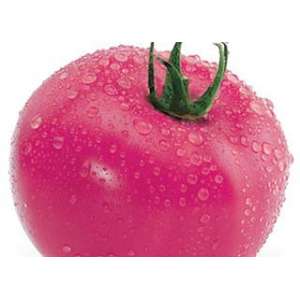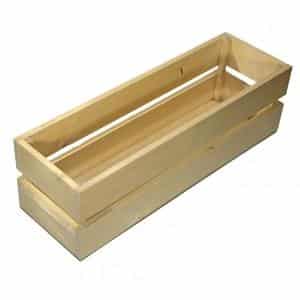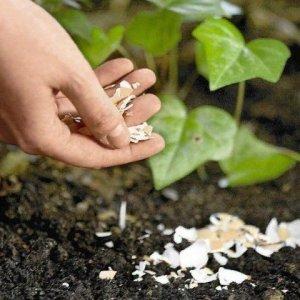Instructions for growing the “Raspberry Ring” tomato: enjoying the beautiful large fruits
Monuments are erected not only to famous people, but even to vegetables! For example, in Ukraine there is a monument called “Glory to the Tomato.” A red bulk tomato is located on a stone pedestal. This is not surprising, because tomatoes are widespread throughout the world and are included in thousands of delicious dishes.
Every gardener dreams of growing a rich harvest of tomatoes, especially since there are many varieties today. Let's pay special attention to a variety called Raspberry Ring. Let's find out where such an unusual name came from and how to get delicious tomatoes.
Description of the variety
Raspberry ringing tomatoes are a new generation hybrid that has excellent yields and stable immunity to common tomato diseases.
The variety reaches about 1.2 m in height. The roots are strong, the bushes are powerful and developed. The leaves are dark green, slightly ribbed.
Distinctive features
It belongs to the mid-early variety, ripens within 90-100 days from planting. Raspberry Ring received its name due to the delicate crimson color of the tomatoes. They are formed together, 5-7 on each hand. The plant is compact and stops developing after the tomatoes are filled.

Characteristics of tomatoes and yield
A smooth, round tomato weighs about 150 g. The skin is glossy and dense, which is why the Raspberry Ring is excellent stored. The pulp is moderately juicy, not watery.
There are few seeds and they are unevenly distributed.Vegetables also ripen well after being picked in a dry and cool place. From one bush, the hybrid produces about 5 kg of beautiful vegetables.
How to grow seedlings
Seedlings are prepared 60 days before planting on the site. The variety is grown both in open ground and in greenhouses. The place of cultivation depends on the natural conditions of the region.
Seed preparation
Hybrid seeds can be purchased in a store or ordered by mail. Even if the manufacturer guarantees the safety and purity of the material, it would be a good idea to disinfect the seeds.
Disinfection will destroy pathogens of dangerous infections and prepare the plant for planting. To do this, place the seeds in a fabric bag, which is placed in the solution. potassium permanganate for 20 minutes. Then take out the material and dry it by simply laying it out on the table.
An important stage in seed preparation is germination. The seeds are placed in damp gauze and placed in a warm place for 1-2 weeks. In this way, the degree of seed germination and their quality are checked.
Important! To speed up germination, use growth stimulants. Zircon and Fitosporin are recognized as effective drugs. The products not only stimulate the development of seeds, but also improve their immunity and prevent them from becoming infected with fungi. The products are sold in powder or solution form. Before use, be sure to read the instructions.
Container and soil
It is most convenient to grow seedlings in ordinary wooden boxes. They are environmentally friendly, affordable and easy to use. It is convenient to care for the sprouts, and the boxes themselves can be moved if necessary. Making boxes from ordinary boards is not very difficult. Also, don't forget to make a tray for each drawer.
Important! In addition to boxes, seedlings are grown in flower pots, plastic cassettes or special containers. The main thing is that the container is dry and clean.
Ready-made soil for seedlings can be purchased at the store. These nutritional compositions are already saturated with all the vitamins for the future plant, have the required level of acidity, and do not contain insect larvae and debris. The “Universal” mixture is recognized as an excellent primer.
Sowing
Wash the container and dry it well. Then place soil in it, filling 1/2 of it. Make grooves in the soil about 2-3 cm deep and place the seeds in them. Sprinkle soil on top and slam down. After sowing, do not forget to water the seedlings generously with warm, filtered water.
We advise Write the name of the variety and the date of planting on the sticker, especially if you are planting other varieties in addition to Raspberry Ringing. Convenient marking will prevent you from getting confused about the varieties and forgetting the planting date.
Growing and care
Do not overheat the seedlings, as too much heat will make them weak. The ideal temperature should be at least 23 degrees. But the seedlings love light, so place the boxes with them in the brightest place in the house. A window sill is perfect, provided there are no drafts or hot radiators.
Moisten the soil generously, but allow it to dry thoroughly between waterings. The first watering occurs 10 days after planting. Remember that too much water increases the risk of developing diseases. Avoid getting moisture on the stems and leaves.
Seedlings must be hardened off - take it out onto the balcony first for 2-3 hours, then increase the time. This is especially true for those who plant Raspberry Ringing under the open sky, and not in a greenhouse. Such procedures make tomatoes stronger.
Important! To make the leaves stronger and more flexible, give the sprouts a kind of “massage session”. Just periodically stroke the leaves with your fingertips. This proven method helps seedlings quickly adapt to mechanical stress.
How to grow tomatoes
The raspberry miracle takes a minimum of time and effort to care for. This is one of the reasons for the popularity of the variety among gardeners.
Landing
The best predecessors for Raspberry Clink are legumes, onions and peppers. Prepare the beds, remove all debris and dig up the soil. Tomatoes should be located at a distance of 40-50 cm from each other. This is necessary so that the roots develop and do not interfere with each other. Once the seedlings are in the ground, water them.
Important! It is best to dig up the ground for the first time in the fall. To create favorable conditions, add sawdust to the ground; it provides natural drainage. On the site, select a bright, spacious and windless place for tomatoes.
Care
Caring for the Raspberry Ring is as follows:
- Regular watering. On average, 1 bush takes 0.5 liters. The frequency of watering is about 7-10 days. Look at the weather: if the summer is hot and dry, then increase the amount of moisture. But do not overdo it, its excess leads to late blight. Watering is most effective if you use a drip irrigation system. You can build it yourself from a regular hose and plastic bottles.
- Loosening the soil. As a result of loosening, the top crust is destroyed and weed sprouts are destroyed. It also ensures air flow to the roots, which is especially important. Frequent loosening reduces the evaporation of internal moisture, and water and liquid fertilizers are better absorbed into the soil.
- Removing weeds. White pigweed, ragweed, and field bindweed are often found in tomato beds. These and other weeds must be removed on time, as they live and feed on water and fertilizers intended for tomatoes. Especially a lot of weeds appear after dew and rain.
- Mulching. The procedure involves placing different materials on tomato beds. Organic mulch is especially effective: straw, humus, compost. They provide additional protection for tomatoes and also nourish them.
- Complex fertilizers. The first feeding is done after 20 days. A nettle-based solution is perfect for it. Subsequent fertilizers are applied every 15-20 days. Tomatoes are especially fond of nitrogen-containing substances. However, be careful, too much of them will only do harm.
Features of cultivation and possible difficulties
During the growing process, gardeners are faced with the problem of yellowing and drying of leaves.. This is explained by the fact that the body lacks macroelements - phosphorus, potassium or magnesium. To solve the problem, use superphosphate, potassium nitrate or potassium humate. If timely measures are not taken, the flowers fall off and the ovaries form poorly.
A lack of nitrogen leads to the formation of chlorosis. The leaves become depleted, the stem hardens and turns red. To prevent chlorosis, use a nutrient solution: 9 liters of liquid manure, 25 g of dry saltpeter, 80 g of wood ash. Tomatoes are watered abundantly. The solution must be used at least 2 weeks before harvest.
Diseases and pests
The hybrid has excellent resistance to fungal infections. However, sometimes the tomato still gets sick late blight, septoria or alternaria.With late blight, brown spots appear, with septoria, yellow leaves are visible, and alternaria appears in the form of depressed dark spots on the leaves and stem. To prevent fungal diseases, spray the plant Bordeaux mixture. The main thing is to wear protective clothing, gloves and goggles before processing.

Among the pests, the Raspberry Ringing beetle is attacked by the wireworm. It damages the root system, which disrupts metabolism and stops the supply of food to the bush.
For preventive purposes, use dry eggshells. Scatter it on the tomato beds and you can forget about the appearance of wireworms.
The nuances of growing in open ground and in a greenhouse
In the greenhouse, the soil is cultivated in the fall. It is recommended to disinfect the soil and structure using fungicides. Fungicides are a group of drugs that prevent the occurrence of diseases.
In addition to the soil, also treat organic plant residues. “Quadris” is recognized as an excellent remedy. This is a complex remedy that protects Raspberry Ring, powdery mildew, and white spotting.
When growing tomatoes in open ground, pay attention to the “neighbors” of the crop. It is not recommended to plant tomatoes next to potatoes or other varieties of tomatoes. If one bush becomes infected, the likelihood of infecting all the others increases. Experienced farmers also plant basil near tomatoes. This plant improves the taste of Raspberry Ring.
Harvesting and application
 Do not allow tomatoes to overripe; remove them as soon as they ripen.. Pick carefully, without damaging the stalk and the stem itself. Dry weather is ideal for harvesting.If you picked a tomato at the stage of milk ripeness, place it in a dark place where it will ripen on its own.
Do not allow tomatoes to overripe; remove them as soon as they ripen.. Pick carefully, without damaging the stalk and the stem itself. Dry weather is ideal for harvesting.If you picked a tomato at the stage of milk ripeness, place it in a dark place where it will ripen on its own.
Raspberry ringing is used to prepare salads, first and second courses. For example, the hybrid is great for baked dishes: lasagna, pizza or julienne. The vegetable is also used in first courses: it is used to prepare borscht, kharcho or tomato puree soup.
In addition, the variety makes excellent jam. Especially if you add ginger root, citrus fruits or vanilla to it.
Interesting! Tomato jam is perfect for meat dishes. Add basil and balsamic vinegar.
Advantages and disadvantages of the variety
The hybrid is one big advantage. It is easy to care for, has excellent taste, excellent presentation and is well stored. In addition, Raspberry Ring is disease resistant and pest resistant.
Among the shortcomings, some gardeners note the poor formation of stepsons. The variety has no more disadvantages.
Farmer reviews
Alexander, St. Petersburg: “I grow mainly hybrids. I like their resistance to disease and insects. I like raspberry ringing because it is tasty and moderately juicy. As a rule, 4-7 tomatoes were tied to a bunch. They are all smooth and beautiful.”
Nikita, Saratov region: “At first, the tomatoes did not take root, they did not form vegetables well and were slow to take on color. But later everything returned to normal. The tomatoes are firm and have a strong tomato aroma. I think I’ll grow more.”
Anastasia, Moscow region: “I planted the raspberry ring without seedlings, and in vain. The bushes quickly gained growth, but became thin and weak. The yield ended up being below average, even though I used chemical fertilizers.”
Conclusion
Compared to most hybrids, Raspberry Ring stands out with its spectacular appearance. Glossy pink tomatoes appeal to many gardeners.
In order not to buy tomatoes in the supermarket, plant the Raspberry Zing variety on your site. Even novice gardeners can grow it. With a little effort, in just 3 months you will be preparing delicious dishes from your own harvest.